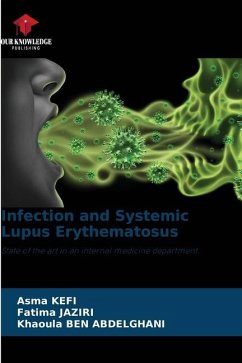With the advent of new therapeutics and the better knowledge of the pathophysiology of systemic lupus erythematosus (SLE), we are witnessing a change in the causes of death: if in the past, patients died more following a relapse of their disease, nowadays other causes such as infection and atherosclerosis are added to and sometimes replace the lupus relapse in terms of mortality. Today, infection is one of the main causes of mortality and morbidity in SLE. In this work, we propose to determine the frequency, the particularities and the predictive elements of the occurrence of infectious complications in SLE. For this purpose, we conducted a retrospective study including 70 lupus patients hospitalized in our department between January 2000 and January 2013. The group of patients with a definite infection was compared with the group without infection. We collected 52 women and 18 men with a mean age at 29 years. Forty-nine patients (70%) had presented 96 infections. Bacterial infections were the most frequently observed.
Bitte wählen Sie Ihr Anliegen aus.
Rechnungen
Retourenschein anfordern
Bestellstatus
Storno








